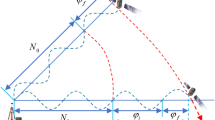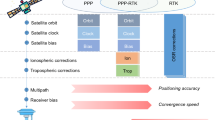Abstract
The PPP-RTK system, which is capable of providing a centimeter-level real-time positioning service for an unlimited number of users, is becoming a promising tool in mass-market applications such as smartphones, the Internet of Things (IoT), and the automotive industry. The extended Kalman filter (EKF) is the conventional method for parameter estimation in the existing PPP-RTK system. Recently, an alternative method known as factor graph optimization (FGO), which fully leverages the time correlation among current and historical measurements, has the potential to further improve the accuracy and robustness of PPP-RTK solutions. In this contribution, a factor graph optimization-based PPP-RTK framework is developed, where raw pseudorange, phase measurements, precise atmospheric corrections, and time-differenced carrier-phase (TDCP) measurements serve as factors in FGO estimators. The continuously tracked phase ambiguities are estimated as the time-invariant state node and propagated by marginalization while ambiguity resolution is conducted independently between epochs. A second optimization process with the utilization of ambiguity-resolved solutions and time-differenced carrier-phase (TDCP) measurements is conducted to further improve the reliability of positioning results. The effectiveness of the proposed method is evaluated by vehicular tests in urban environments. Results indicate that the FGO method could improve the performance of ambiguity resolution by reducing the ambiguity search space and increasing the ratio values, leading to a significant accuracy improvement of 55% in an open-sky environment compared to the traditional EKF-based method. Furthermore, in GNSS signal partly block scenes, the FGO-based PPP-RTK is capable of obtaining more robust and accurate positioning solutions with fewer outliers compared to the EKF method.


















Similar content being viewed by others
Availability of Data and materials
Datasets collected in the road vehicular test campaign as well as the observation data of reference stations are available on the website of the international GNSS Monitoring and Assessment System (iGMAS) Innovation Center (http://igmas.users.sgg.whu.edu.cn/group/tool/19).
References
Agarwal S, Mierle K (2012) Ceres solver: tutorial and reference. Google Inc 2(72):8
Bai X, Wen W, Hsu LT (2022) Time-correlated window-carrier-phase-aided GNSS positioning using factor graph optimization for urban positioning. IEEE Trans Aerosp Electron Syst 58(4):3370–3384
Breßler J, Reisdorf P, Obst M, Wanielik G (2016) GNSS positioning in non-line-of-sight context—a survey. In: Proceedings of IEEE 19th international conference on intelligent transportation systems (ITSC), Rio de Janeiro, Brazil, Nov 1–4, pp 1147–1154
Chen D, Gao GX (2019) Probabilistic graphical fusion of LiDAR, GPS, and 3D building maps for urban UAV navigation. Navigation 66(1):151–168
Chen Y, Sheng Z, Jay AF (2015) Computationally efficient carrier integer ambiguity resolution in multi-epoch GPS/INS: a common-position-shift approach. IEEE Trans Control Syst Technol 24(5):1541–1556
Das S, Watson R, Gross J (2021) Review of factor graphs for robust GNSS applications. arXiv preprint. arXiv:2112.07794
Dellaert F, Kaess M (2017) Factor graphs for robot perception. Found Trends Robot 6(1–2):1–139
Fang R, Shi C, Wei N, Zhao Q (2009) Real-time cycle-slip detection for quality control of GPS measurements. Geomat Inf Sci Wuhan Univ 34(9):1094–1097
Gao H, Li H, Huo H, Yang C (2022) Robust GNSS real-time kinematic with ambiguity resolution in factor graph optimization. In: Proceedings of the international technical meeting of The Institute of Navigation, California, USA, January 25–27, pp 835–843
Geng J, Guo J, Meng X, Gao K (2020) Speeding up PPP ambiguity resolution using triple-frequency GPS/BeiDou/Galileo/QZSS data. J Geodesy 94:1–15
Han H, Wang J, Wang J, Moraleda AH (2017) Reliable partial ambiguity resolution for single-frequency GPS/BDS and INS integration. GPS Solut 21(1):251–264
Iwase T, Kojima Y, Teramoto E (2012) M-epoch ambiguity resolution technique for single frequency receivers with INS aid. In: Proceedings of IEEE/ION position, location and navigation symposium, SC, USA, April 23–26, pp 706–710
Kaess M, Johannsson H, Roberts R, Ila V, Leonard JJ, Dellaert F (2012) iSAM2: incremental smoothing and mapping using the Bayes tree. Int J Robot Res 31(2):216–235
Kouba J (2015) A guide to using international GNSS service (IGS) products, September 2015 update. http://kb.igs.org/hc/en-us/articles/201271873-A-Guide-to-Using-the-IGS-Products
Li X, Li X, Yuan Y, Zhang K, Zhang X, Wickert J (2018) Multi-GNSS phase delay estimation and PPP ambiguity resolution: GPS, BDS, GLONASS Galileo. J Geod 92(6):579–608
Li X, Li X, Liu G, Yuan Y, Freeshah M, Zhang K, Zhou F (2020) BDS multi-frequency PPP ambiguity resolution with new B2a/B2b/B2a+ b signals and legacy B1I/B3I signals. J Geodesy 94:1–15
Li X, Li X, Huan J, Shen Z, Wang B, Yuan Y, Zhang K (2021a) Improving PPP–RTK in urban environment by tightly coupled integration of GNSS and INS. J Geod 95:1–18
Li X, Han X, Li X, Liu G, Feng G, Wang B, Zheng H (2021b) GREAT-UPD: an open-source software for uncalibrated phase delay estimation based on multi-GNSS and multi-frequency observations. GPS Solut 25:1–9
Li X, Huang J, Li X, Shen Z, Han J, Li L, Wang B (2022a) Review of PPP–RTK: achievements, challenges, and opportunities. Satell Navig 3(1):28
Li X, Wang B, Li X, Huang J, Lyu H, Han X (2022b) Principle and performance of multi-frequency and multi-GNSS PPP-RTK. Satell Navig 3(1):1–11
Liu Y, Song W, Lou Y, Ye S, Zhang R (2017) GLONASS phase bias estimation and its PPP ambiguity resolution using homogeneous receivers. GPS Solut 21(2):427–437
Lyu P, Bai S, Lai J, Wang B, Sun X, Huang K (2021) Optimal time difference-based TDCP-GPS/IMU navigation using graph optimization. IEEE Trans Instrum Meas 70:1–10
Nocedal J, Wright SJ (2006) Numerical optimization, vol 35. Springer Science, New York, p 7
NovAtel Corporation (2018) Inertial Explorer 8.70 User Manual. https://novatel.com/support/support-materials/manual. Accessed 1 July 2020
Odijk D, Zhang B, Khodabandeh A, Odolinski R, Teunissen PJ (2016) On the estimability of parameters in undifferenced, uncombined GNSS network and PPP-RTK user models by means of S-system theory. J Geod 90:15–44
Pfeifer T, Protzel P (2018) Robust sensor fusion with self-tuning mixture models. In: Proceedings of IEEE/RSJ international conference on intelligent robots and systems (IROS), Madrid, Spain, Oct 1–5, pp 3678–3685
Pfeifer T, Protzel P (2019) Expectation–maximization for adaptive mixture models in graph optimization. In: Proceedings of the international conference on robotics and automation (ICRA), Montreal, QC, Canada. May 20–24, pp 3151–3157. https://doi.org/10.1109/ICRA.2019.8793601
Pfeifer T, Lange S, Protzel P (2017) Dynamic covariance estimation—a parameter free approach to robust sensor fusion. In: Proceedings of IEEE international conference on multi-sensor fusion and integration for intelligent systems (MFI), Daegu, Korea (South), Nov16–18, pp 359–365
Psychas D, Verhagen S (2020) Real-time PPP-RTK performance analysis using ionospheric corrections from multi-scale network configurations. Sensors 20(11):3012
Rizos C (2009) Network RTK research and implementation-a geodetic perspective. Positioning 1(2):144–150
Saastamoinen J (1972) Atmospheric correction for the troposphere and stratosphere in radio ranging satellites. Use Artif Satell Geod 15:247–251
Sibley G, Matthies L, Sukhatme G (2010) Sliding window filter with application to planetary landing. J Field Robot 27(5):587–608
Strasdat H, Montiel JM, Davison AJ (2012) Visual SLAM: why filter? Image vis Comput 30(2):65–77
Sünderhauf N, Protzel P (2012) Towards robust graphical models for GNSS-based localization in urban environments. In: Proceedings of the international multi-conference on systems, signals & devices. Chemnitz, Germany, March 20–23, pp 1–6. https://doi.org/10.1109/SSD.2012.6198059.
Teunissen PJG (1995) The least-squares ambiguity decorrelation adjustment: a method for fast GPS integer ambiguity estimation. J Geodesy 70(1–2):65–82
Teunissen PJG (2002) Quality control in integrated navigation systems. IEEE Aerosp Electron Syst Mag 5(7):35–41
Teunissen PJG, Khodabandeh A (2015) Review and principles of PPP-RTK methods. J Geod 89(3):217–240
Teunissen P, Odijk D, Zhang B (2010) PPP-RTK: results of CORS network-based PPP with integer ambiguity resolution. J Aeronaut Astronaut Aviat Ser A 42(4):223–230
Wang X, Li X, Shen Z, Li X, Zhou Y, Chang H (2023) Factor graph optimization-based multi-GNSS real-time kinematic system for robust and precise positioning in urban canyons. GPS Solut 27(4):200
Watson M, Gross N (2017) Robust navigation in GNSS degraded environment using graph optimization. In: Proceedings of the 30th international technical meeting of the satellite division of the institute of navigation (ION GNSS+2017), Portland, Oregon, September 25–29, pp 2906–2918
Watson M, Gross N (2018) Evaluation of kinematic precise point positioning convergence with an incremental graph optimizer. In: Proceedings of the IEEE/ION position, location and navigation symposium (PLANS), Monterey, USA, April 23–26, pp 589–596
Wen W, Hsu LT (2021) Towards robust GNSS positioning and Real-time kinematic using factor graph optimization. In: Proceedings of the international conference on robotics and automation (ICRA), Xi’an, China, May 30–June 05, pp 5884–5890
Wen W, Pfeifer T, Bai X, Hsu LT (2020) Comparison of extended Kalman filter and factor graph optimization for GNSS/INS integrated navigation system. arXiv preprint arXiv:2004.10572
Wilbers D, Merfels C, Stachniss C (2019) Localization with sliding window factor graphs on third-party maps for automated driving. In: 2019 international conference on robotics and automation (ICRA), pp 5951–5957
Wübbena G, Schmitz M, Bagg A (2005) PPP-RTK: precise point pzositioning using state-space representation in RTK networks. In: Proceedings of the 18th international technical meeting of the satellite division of the Institute of navigation (ION GNSS 2005), Long Beach, CA, September 13–16, pp 2584–2594
Yu W, Ding X, Chen W, Dai W, Yi Z, Zhang B (2019) Precise point positioning with mixed use of time-differenced and undifferenced carrier phase from multiple GNSS. J Geod 93:809–818
Zhang B, Chen Y, Yuan Y (2019) PPP-RTK based on undifferenced and uncombined observations: theoretical and practical aspects. J Geod 93:1011–1024
Zhang B, Hou P, Zha J, Liu T (2022) PPP–RTK functional models formulated with undifferenced and uncombined GNSS observations. Satell Navig 3(1):3
Zumberge JF, Heflin MB, Jefferson DC, Watkins MM, Webb FH (1997) Precise point positioning for the efficient and robust analysis of GPS data from large networks. J Geophys Res 102(B3):5005–5017. https://doi.org/10.1029/96JB03860
Acknowledgements
This work has been supported by the National Natural Science Foundation of China (No. 42204017), the special fund of Hubei Luojia Laboratory (220100006), the National Postdoctoral Program for Innovative Talents, China (No. BX20220239). The algorithm implementation is based on the GNSS+ REsearch, Application and Teaching (GREAT) software developed by the GREAT Group, School of Geodesy and Geomatics, Wuhan University. The numerical calculations in this paper have been done on the supercomputing system in the Supercomputing Center of Wuhan University.
Author information
Authors and Affiliations
Contributions
X.L. and XX.L. provided the initial idea and designed the experiments for this study; X.L., XX.L., X.W., and H.C. analyzed the data and wrote the manuscript; Y.T. and Z.S. helped with the writing. All authors reviewed the manuscript.
Corresponding author
Rights and permissions
Springer Nature or its licensor (e.g. a society or other partner) holds exclusive rights to this article under a publishing agreement with the author(s) or other rightsholder(s); author self-archiving of the accepted manuscript version of this article is solely governed by the terms of such publishing agreement and applicable law.
About this article
Cite this article
Li, X., Li, X., Wang, X. et al. Factor graph-based PPP-RTK for accurate and robust positioning in urban environments. J Geod 98, 21 (2024). https://doi.org/10.1007/s00190-024-01828-3
Received:
Accepted:
Published:
DOI: https://doi.org/10.1007/s00190-024-01828-3




